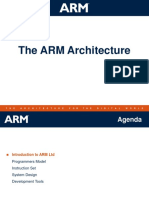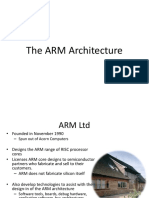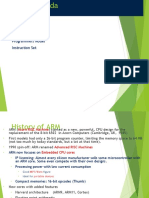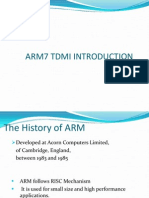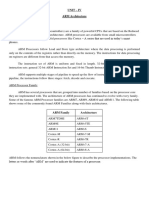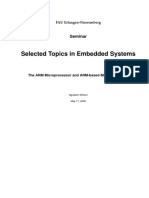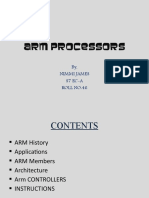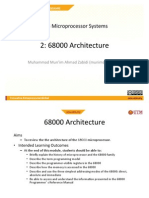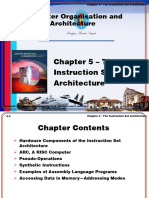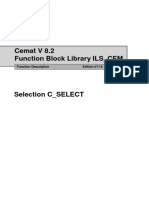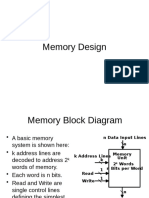The ARM Architecture
T TM
R1 L
�Agenda
Introduction to ARM Ltd Programmers Model Instruction Set System Design Development Tools
39v10 The ARM Architecture
TM
�ARM Ltd
Founded in November 1990
Spun out of Acorn Computers
Designs the ARM range of RISC processor cores Licenses ARM core designs to semiconductor partners who fabricate and sell to their customers.
ARM does not fabricate silicon itself
Also develop technologies to assist with the design-in of the ARM architecture
Software tools, boards, debug hardware, application software, bus architectures, peripherals etc
39v10 The ARM Architecture
TM
�ARM Partnership Model
39v10 The ARM Architecture
TM
�ARM Powered Products
39v10 The ARM Architecture
TM
�Intellectual Property
ARM provides hard and soft views to licencees
RTL and synthesis flows GDSII layout
Licencees have the right to use hard or soft views of the IP
soft views include gate level netlists hard views are DSMs
OEMs must use hard views
to protect ARM IP
39v10 The ARM Architecture
TM
�Agenda
Introduction to ARM Ltd Programmers Model Instruction Sets System Design Development Tools
39v10 The ARM Architecture
TM
�Data Sizes and Instruction Sets
The ARM is a 32-bit architecture.
When used in relation to the ARM:
Byte means 8 bits Halfword means 16 bits (two bytes) Word means 32 bits (four bytes)
Most ARMs implement two instruction sets
32-bit ARM Instruction Set 16-bit Thumb Instruction Set
Jazelle cores can also execute Java bytecode
39v10 The ARM Architecture
TM
�Processor Modes
The ARM has seven basic operating modes:
User : unprivileged mode under which most tasks run FIQ : entered when a high priority (fast) interrupt is raised IRQ : entered when a low priority (normal) interrupt is raised Supervisor : entered on reset and when a Software Interrupt instruction is executed Abort : used to handle memory access violations Undef : used to handle undefined instructions System : privileged mode using the same registers as user mode
39v10 The ARM Architecture
TM
�The ARM Register Set
Current Visible Registers
Abort Undef Mode SVC Mode IRQ Mode FIQ Mode User Mode
r0 r1 r2 r3 r4 r5 r6 r7 r8 r9 r10 r11 r12 r13 (sp) r14 (lr) r15 (pc) cpsr spsr
Banked out Registers
User
r8 r9 r10 r11 r12 r13 (sp) r14 (lr)
FIQ
r8 r9 r10 r11 r12 r13 (sp) r14 (lr)
IRQ
SVC
Undef
Abort
r13 (sp) r14 (lr)
r13 (sp) r14 (lr)
r13 (sp) r14 (lr)
r13 (sp) r14 (lr)
spsr
spsr
spsr
spsr
spsr
39v10 The ARM Architecture
TM
10
10
�Register Organization Summary
User
r0 r1 r2 r3 r4 r5 r6 r7 r8 r9 r10 r11 r12 r13 (sp) r14 (lr) r15 (pc) cpsr spsr spsr spsr spsr spsr
FIQ
IRQ
SVC
Undef
Abort
User mode r0-r7, r15, and cpsr
r8 r9 r10 r11 r12 r13 (sp) r14 (lr)
User mode r0-r12, r15, and cpsr
User mode r0-r12, r15, and cpsr
User mode r0-r12, r15, and cpsr
User mode r0-r12, r15, and cpsr
Thumb state Low registers
Thumb state High registers
r13 (sp) r14 (lr) r13 (sp) r14 (lr) r13 (sp) r14 (lr) r13 (sp) r14 (lr)
Note: System mode uses the User mode register set
39v10 The ARM Architecture
TM
11
11
�The Registers
ARM has 37 registers all of which are 32-bits long.
1 dedicated program counter 1 dedicated current program status register 5 dedicated saved program status registers 30 general purpose registers
The current processor mode governs which of several banks is accessible. Each mode can access
a particular set of r0-r12 registers a particular r13 (the stack pointer, sp) and r14 (the link register, lr) the program counter, r15 (pc) the current program status register, cpsr
Privileged modes (except System) can also access
a particular spsr (saved program status register)
39v10 The ARM Architecture
TM
12
12
�Program Status Registers
31 28 27 24 23 16 15 8 7 6 5 4 0
N Z C V Q f
n s
e x
I F T c
mode
Condition code flags
N = Negative result from ALU Z = Zero result from ALU C = ALU operation Carried out V = ALU operation oVerflowed
Interrupt Disable bits.
I = 1: Disables the IRQ. F = 1: Disables the FIQ.
T Bit
Architecture xT only T = 0: Processor in ARM state T = 1: Processor in Thumb state
Sticky Overflow flag - Q flag
Architecture 5TE/J only Indicates if saturation has occurred
Mode bits J bit
Architecture 5TEJ only J = 1: Processor in Jazelle state Specify the processor mode
39v10 The ARM Architecture
TM
13
13
�Program Counter (r15)
When the processor is executing in ARM state:
All instructions are 32 bits wide All instructions must be word aligned Therefore the pc value is stored in bits [31:2] with bits [1:0] undefined (as instruction cannot be halfword or byte aligned).
When the processor is executing in Thumb state:
All instructions are 16 bits wide All instructions must be halfword aligned Therefore the pc value is stored in bits [31:1] with bit [0] undefined (as instruction cannot be byte aligned).
When the processor is executing in Jazelle state:
All instructions are 8 bits wide Processor performs a word access to read 4 instructions at once
39v10 The ARM Architecture
TM
14
14
�Exception Handling
When an exception occurs, the ARM:
Copies CPSR into SPSR_<mode> Sets appropriate CPSR bits
Change to ARM state Change to exception mode Disable interrupts (if appropriate)
0x1C 0x18 0x14 0x10 0x0C 0x08 0x04 0x00
FIQ IRQ (Reserved) Data Abort Prefetch Abort
Software Interrupt Undefined Instruction
Stores the return address in LR_<mode> Sets PC to vector address
To return, exception handler needs to:
Restore CPSR from SPSR_<mode> Restore PC from LR_<mode>
Reset
This can only be done in ARM state.
Vector Table
Vector table can be at 0xFFFF0000 on ARM720T and on ARM9/10 family devices
39v10 The ARM Architecture
TM
15
15
�Development of the ARM Architecture
Halfword and signed halfword / byte support System mode
4
SA-110 SA-1110
1 2 3
Early ARM architectures
Improved ARM/Thumb Interworking CLZ
5TE
Jazelle Java bytecode execution ARM9EJ-S ARM7EJ-S
5TEJ
Saturated maths DSP multiplyaccumulate instructions ARM1020E
ARM926EJ-S ARM1026EJ-S
Thumb instruction set ARM7TDMI ARM720T
SIMD Instructions Multi-processing
4T
ARM9TDMI ARM940T
XScale ARM9E-S ARM966E-S
V6 Memory architecture (VMSA) Unaligned data support ARM1136EJ-S
39v10 The ARM Architecture
TM
16
16
�Agenda
Introduction to ARM Ltd Programmers Model Instruction Sets System Design Development Tools
39v10 The ARM Architecture
TM
17
17
�Conditional Execution and Flags
ARM instructions can be made to execute conditionally by postfixing them with the appropriate condition code field.
This improves code density and performance by reducing the number of forward branch instructions.
CMP BEQ ADD skip r3,#0 skip r0,r1,r2 CMP r3,#0 ADDNE r0,r1,r2
By default, data processing instructions do not affect the condition code flags but the flags can be optionally set by using S. CMP does not need S.
loop SUBS r1,r1,#1 BNE loop
decrement r1 and set flags if Z flag clear then branch
39v10 The ARM Architecture
TM
18
18
�Condition Codes
The possible condition codes are listed below:
Note AL is the default and does not need to be specified
Suffix Description Equal Not equal Unsigned higher or same Unsigned lower Minus Positive or Zero Overflow No overflow Unsigned higher Unsigned lower or same Greater or equal Less than Greater than Less than or equal Always Flags tested Z=1 Z=0 C=1 C=0 N=1 N=0 V=1 V=0 C=1 & Z=0 C=0 or Z=1 N=V N!=V Z=0 & N=V Z=1 or N=!V
EQ NE CS/HS CC/LO MI PL VS VC HI LS GE LT GT LE AL
39v10 The ARM Architecture
TM
19
19
�Examples of conditional execution
Use a sequence of several conditional instructions
if (a==0) func(1); CMP r0,#0 MOVEQ r0,#1 BLEQ func
Set the flags, then use various condition codes
if (a==0) x=0; if (a>0) x=1; CMP r0,#0 MOVEQ r1,#0 MOVGT r1,#1
Use conditional compare instructions
if (a==4 || a==10) x=0; CMP r0,#4 CMPNE r0,#10 MOVEQ r1,#0
39v10 The ARM Architecture
TM
20
20
�Branch instructions
Branch : Branch with Link : B{<cond>} label BL{<cond>} subroutine_label
31
28 27
25 24 23
Cond
1 0 1 L
Offset
Link bit
0 = Branch 1 = Branch with link
Condition field
The processor core shifts the offset field left by 2 positions, sign-extends it and adds it to the PC
32 Mbyte range How to perform longer branches?
39v10 The ARM Architecture
TM
21
21
�Data processing Instructions
Consist of :
Arithmetic: Logical: Comparisons: Data movement:
ADD AND CMP MOV
ADC ORR CMN MVN
SUB EOR TST
SBC BIC TEQ
RSB
RSC
These instructions only work on registers, NOT memory. Syntax: <Operation>{<cond>}{S} Rd, Rn, Operand2
Comparisons set flags only - they do not specify Rd Data movement does not specify Rn
Second operand is sent to the ALU via barrel shifter.
39v10 The ARM Architecture
TM
22
22
�The Barrel Shifter
LSL : Logical Left Shift
CF
ASR: Arithmetic Right Shift
Destination
CF
Destination
Multiplication by a power of 2
Division by a power of 2, preserving the sign bit
LSR : Logical Shift Right
...0
ROR: Rotate Right
Destination
CF
Destination
Division by a power of 2
CF
Bit rotate with wrap around from LSB to MSB
RRX: Rotate Right Extended
Destination
CF
Single bit rotate with wrap around from CF to MSB
39v10 The ARM Architecture
TM
23
23
�Using the Barrel Shifter: The Second Operand
Operand 1 Operand 2
Register, optionally with shift operation
Shift value can be either be:
5 bit unsigned integer Specified in bottom byte of another register. Barrel Shifter
Used for multiplication by constant
Immediate value
8 bit number, with a range of 0-255.
ALU Rotated right through even number of positions
Allows increased range of 32-bit constants to be loaded directly into registers
Result
39v10 The ARM Architecture
TM
24
24
�Immediate constants (1)
No ARM instruction can contain a 32 bit immediate constant
All ARM instructions are fixed as 32 bits long
The data processing instruction format has 12 bits available for operand2
11 rot x2 8 7 immed_8 0
Quick Quiz:
Shifter ROR
0xe3a004ff MOV r0, #???
4 bit rotate value (0-15) is multiplied by two to give range 0-30 in steps of 2 Rule to remember is 8-bits shifted by an even number of bit positions.
39v10 The ARM Architecture
TM
25
25
�Immediate constants (2)
Examples:
31 0
ror #0 ror #8 ror #30
0 0 0 0 0 0 0 0 0 0 0 0 0 0 0 0 0 0 0 0 0 0 0 0
range 0-0x000000ff step 0x00000001 range 0-0xff000000 step 0x01000000 range 0-0x000003fc step 0x00000004
0 0 0 0 0 0 0 0 0 0 0 0 0 0 0 0 0 0 0 0 0 0 0 0
0 0 0 0 0 0 0 0 0 0 0 0 0 0 0 0 0 0 0 0 0 0
0 0
The assembler converts immediate values to the rotate form: MOV r0,#4096 ; uses 0x40 ror 26 ADD r1,r2,#0xFF0000 ; uses 0xFF ror 16
The bitwise complements can also be formed using MVN: MOV r0, #0xFFFFFFFF ; assembles to MVN r0,#0
Values that cannot be generated in this way will cause an error.
39v10 The ARM Architecture
TM
26
26
�Loading 32 bit constants
To allow larger constants to be loaded, the assembler offers a pseudoinstruction: LDR rd, =const This will either: Produce a MOV or MVN instruction to generate the value (if possible). or
Generate a LDR instruction with a PC-relative address to read the constant from a literal pool (Constant data area embedded in the code).
For example LDR r0,=0xFF LDR r0,=0x55555555
=> =>
MOV r0,#0xFF LDR r0,[PC,#Imm12] DCD 0x55555555
This is the recommended way of loading constants into a register
39v10 The ARM Architecture
TM
27
27
�Multiply
Syntax:
MUL{<cond>}{S} Rd, Rm, Rs MLA{<cond>}{S} Rd,Rm,Rs,Rn [U|S]MULL{<cond>}{S} RdLo, RdHi, Rm, Rs [U|S]MLAL{<cond>}{S} RdLo, RdHi, Rm, Rs Rd = Rm * Rs Rd = (Rm * Rs) + Rn RdHi,RdLo := Rm*Rs RdHi,RdLo := (Rm*Rs)+RdHi,RdLo
Cycle time
Basic MUL instruction
2-5 cycles on ARM7TDMI 1-3 cycles on StrongARM/XScale 2 cycles on ARM9E/ARM102xE
+1 cycle for ARM9TDMI (over ARM7TDMI) +1 cycle for accumulate (not on 9E though result delay is one cycle longer) +1 cycle for long
Above are general rules - refer to the TRM for the core you are using for the exact details
39v10 The ARM Architecture
TM
28
28
�Single register data transfer
LDR LDRB LDRH LDRSB LDRSH STR STRB STRH Word Byte Halfword Signed byte load Signed halfword load
Memory system must support all access sizes
Syntax:
LDR{<cond>}{<size>} Rd, <address> STR{<cond>}{<size>} Rd, <address> e.g. LDREQB
39v10 The ARM Architecture
TM
29
29
�Address accessed
Address accessed by LDR/STR is specified by a base register plus an offset For word and unsigned byte accesses, offset can be
An unsigned 12-bit immediate value (ie 0 - 4095 bytes).
LDR r0,[r1,#8]
A register, optionally shifted by an immediate value
LDR r0,[r1,r2] LDR r0,[r1,r2,LSL#2]
This can be either added or subtracted from the base register:
LDR r0,[r1,#-8] LDR r0,[r1,-r2] LDR r0,[r1,-r2,LSL#2]
For halfword and signed halfword / byte, offset can be:
An unsigned 8 bit immediate value (ie 0-255 bytes). A register (unshifted).
Choice of pre-indexed or post-indexed addressing
39v10 The ARM Architecture
TM
30
30
�Pre or Post Indexed Addressing?
Pre-indexed: STR r0,[r1,#12]
Offset 12 r1 Base Register 0x200
0x200 0x20c
r0 0x5 0x5
Source Register for STR
Auto-update form: STR r0,[r1,#12]!
Post-indexed: STR r0,[r1],#12
Updated Base Register Original Base Register r1 0x20c r1 0x200
0x200
Offset 12
0x20c
r0 0x5 0x5
Source Register for STR
39v10 The ARM Architecture
TM
31
31
�LDM / STM operation
Syntax: <LDM|STM>{<cond>}<addressing_mode> Rb{!}, <register list> 4 addressing modes:
LDMIA / STMIA LDMIB / STMIB LDMDA / STMDA LDMDB / STMDB increment after increment before decrement after decrement before
IA LDMxx r10, {r0,r1,r4} STMxx r10, {r0,r1,r4}
Base Register (Rb) r10
r4 r1 r0
IB
r4 r1 r0
DA
DB
r4 r1 r0 r4 r1 r0
Increasing Address
39v10 The ARM Architecture
TM
32
32
�Software Interrupt (SWI)
31 28 27 24 23 0
Cond
1 1 1 1
SWI number (ignored by processor)
Condition Field
Causes an exception trap to the SWI hardware vector The SWI handler can examine the SWI number to decide what operation has been requested. By using the SWI mechanism, an operating system can implement a set of privileged operations which applications running in user mode can request. Syntax: SWI{<cond>} <SWI number>
39v10 The ARM Architecture
TM
33
33
�PSR Transfer Instructions
31 28 27 24 23 16 15 8 7 6 5 4 0
N Z C V Q f
n s
e x
I F T c
mode
MRS and MSR allow contents of CPSR / SPSR to be transferred to / from a general purpose register. Syntax:
MRS{<cond>} Rd,<psr> ; Rd = <psr> MSR{<cond>} <psr[_fields]>,Rm ; <psr[_fields]> = Rm
where
<psr> = CPSR or SPSR [_fields] = any combination of fsxc
Also an immediate form
MSR{<cond>} <psr_fields>,#Immediate
In User Mode, all bits can be read but only the condition flags (_f) can be written.
39v10 The ARM Architecture
TM
34
34
�ARM Branches and Subroutines
B <label>
PC relative. 32 Mbyte range.
BL <subroutine>
Stores return address in LR Returning implemented by restoring the PC from LR For non-leaf functions, LR will have to be stacked
func1
: : BL func1 : : STMFD sp!,{regs,lr} :
func2
: : :
BL func2 : : : LDMFD sp!,{regs,pc} MOV pc, lr
39v10 The ARM Architecture
TM
35
35
�Thumb
Thumb is a 16-bit instruction set
Optimised for code density from C code (~65% of ARM code size) Improved performance from narrow memory Subset of the functionality of the ARM instruction set
Core has additional execution state - Thumb
Switch between ARM and Thumb using BX instruction
31
ADDS r2,r2,#1 32-bit ARM Instruction
For most instructions generated by compiler: Conditional execution is not used Source and destination registers identical Only Low registers used Constants are of limited size Inline barrel shifter not used
15
ADD r2,#1
16-bit Thumb Instruction
39v10 The ARM Architecture
TM
36
36
�Agenda
Introduction Programmers Model Instruction Sets System Design Development Tools
39v10 The ARM Architecture
TM
37
37
�Example ARM-based System
16 bit RAM
32 bit RAM Interrupt Controller
nIRQ nFIQ
Peripherals
I/O
8 bit ROM
ARM Core
39v10 The ARM Architecture
TM
38
38
�AMBA
Arbiter Reset
ARM
TIC Bridge External ROM External RAM Bus Interface External Bus Interface On-chip RAM Timer Remap/ Pause
Decoder
Interrupt Controller
AHB or ASB System Bus
APB Peripheral Bus
AMBA
Advanced Microcontroller Bus Architecture
ACT
AMBA Compliance Testbench
ADK
Complete AMBA Design Kit
PrimeCell
ARMs AMBA compliant peripherals
39v10 The ARM Architecture
TM
39
39
�Agenda
Introduction Programmers Model Instruction Sets System Design Development Tools
39v10 The ARM Architecture
TM
40
40
�The RealView Product Families
Compilation Tools
ARM Developer Suite (ADS) Compilers (C/C++ ARM & Thumb), Linker & Utilities
Debug Tools
AXD (part of ADS) Trace Debug Tools Multi-ICE Multi-Trace
Platforms
ARMulator (part of ADS) Integrator Family
RealView Compilation Tools (RVCT)
RealView Debugger (RVD) RealView ICE (RVI) RealView Trace (RVT)
RealView ARMulator ISS (RVISS)
39v10 The ARM Architecture
TM
41
41
�ARM Debug Architecture
Ethernet
Debugger (+ optional trace tools)
EmbeddedICE Logic
Provides breakpoints and processor/system access
JTAG port
Trace Port
JTAG interface (ICE)
Converts debugger commands to JTAG signals
TAP controller
ETM
EmbeddedICE Logic
Embedded trace Macrocell (ETM)
Compresses real-time instruction and data access trace Contains ICE features (trigger & filter logic)
Trace port analyzer (TPA)
Captures trace in a deep buffer
39v10 The ARM Architecture
TM
ARM core
42
42




